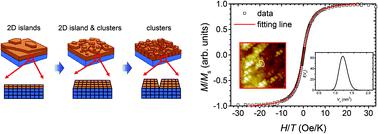Our official English website, www.x-mol.net, welcomes your
feedback! (Note: you will need to create a separate account there.)
A practical method for fabricating superparamagnetic films and the mechanism involved.
Nanoscale ( IF 5.8 ) Pub Date : 2020-06-04 , DOI: 10.1039/c9nr10053a Pei-Cheng Jiang,Cheng-Hsun-Tony Chang,Chen-Yuan Hsieh,Wei-Bin Su,Jyh-Shen Tsay
Nanoscale ( IF 5.8 ) Pub Date : 2020-06-04 , DOI: 10.1039/c9nr10053a Pei-Cheng Jiang,Cheng-Hsun-Tony Chang,Chen-Yuan Hsieh,Wei-Bin Su,Jyh-Shen Tsay

|
Due to the widespread applications of biosensors, such as in magnetic resonance imaging, cancer detection and drug delivery, the use of superparamagnetic materials for preparing biosensors has increased greatly. We report herein on a strategy toward fabrication of a nanoscale biosensor composed of superparamagnetic films. On increasing the film thickness of magnetic layers, a phase transition typically occurs from either a low-Curie-temperature state or a superparamagnetic state to a ferromagnetic state. A new finding is demonstrated wherein a phase transition of such a superparamagnetic phase can be induced by controlling the thickness of ultrathin ferromagnetic layers with perpendicular magnetic anisotropy. Both the M–H curve with zero coercive force at 300 K and deviations of the normalized hysteresis loop at 2 K confirm the superparamagnetic state of Co/Ir(111) at room temperature. An overstrained film transforming into clusters (OFTC) model based on the new finding and our experimental evidence is proposed for modeling this phenomenon. From the energetic point of view of the OFTC model, we propose a limited distortion mechanism that can be useful in determining the critical thickness for the phase transition. This mechanism considers the balance between interfacial strain energy and surface free energy. A method for producing superparamagnetic films by taking advantage of the accumulation of strain and relaxation is reported.
中文翻译:

一种制造超顺磁性薄膜的实用方法及其所涉及的机理。
由于生物传感器的广泛应用,例如在磁共振成像,癌症检测和药物输送中,超顺磁性材料在制备生物传感器中的使用已大大增加。我们在这里报告了一种由超顺磁性薄膜组成的纳米级生物传感器的制造策略。在增加磁性层的膜厚度时,通常发生从低居里温度状态或超顺磁性状态到铁磁性状态的相变。证明了新发现,其中可以通过控制具有垂直磁各向异性的超薄铁磁层的厚度来诱发这种超顺磁相的相变。无论是中号- ^ h在300 K时矫顽力为零的曲线和在2 K时归一化的磁滞回线的偏差证实了Co / Ir(111)在室温下的超顺磁态。基于这一新发现,我们提出了一种将薄膜过度变形成簇(OFTC)的模型,并提供了我们的实验证据来对该现象进行建模。从OFTC模型的能量角度来看,我们提出了一种有限的失真机制,该机制可用于确定相变的临界厚度。该机制考虑了界面应变能和表面自由能之间的平衡。报道了一种利用应变的累积和弛豫来制造超顺磁性膜的方法。
更新日期:2020-07-09
中文翻译:

一种制造超顺磁性薄膜的实用方法及其所涉及的机理。
由于生物传感器的广泛应用,例如在磁共振成像,癌症检测和药物输送中,超顺磁性材料在制备生物传感器中的使用已大大增加。我们在这里报告了一种由超顺磁性薄膜组成的纳米级生物传感器的制造策略。在增加磁性层的膜厚度时,通常发生从低居里温度状态或超顺磁性状态到铁磁性状态的相变。证明了新发现,其中可以通过控制具有垂直磁各向异性的超薄铁磁层的厚度来诱发这种超顺磁相的相变。无论是中号- ^ h在300 K时矫顽力为零的曲线和在2 K时归一化的磁滞回线的偏差证实了Co / Ir(111)在室温下的超顺磁态。基于这一新发现,我们提出了一种将薄膜过度变形成簇(OFTC)的模型,并提供了我们的实验证据来对该现象进行建模。从OFTC模型的能量角度来看,我们提出了一种有限的失真机制,该机制可用于确定相变的临界厚度。该机制考虑了界面应变能和表面自由能之间的平衡。报道了一种利用应变的累积和弛豫来制造超顺磁性膜的方法。











































 京公网安备 11010802027423号
京公网安备 11010802027423号